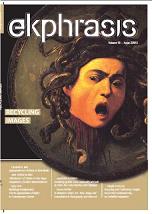In Praise of Translation – Recent Intermedial Transpositions in Video, Print and Installation
In Praise of Translation – Recent Intermedial Transpositions in Video, Print and Installation
Author(s): Ruth Pelzer-MontadaSubject(s): Theatre, Dance, Performing Arts
Published by: Universitatea Babeş-Bolyai, Facultatea de Teatru si Televiziune
Keywords: translation; copy; intermediality; contemporary art; expanded printmaking
Summary/Abstract: In this essay different approaches to recycling images, generated by diverse technologies from historical print to most recent digital video, are discussed with reference to the notion of translation. In a broad interpretation of the notion of ‘recycling,’ the concept and practice of ‘translation’ serves as a methodological tool. Specifically, it aids the elucidation not only of the reusing of imagery, but of media and processes in the context of ‘expanded printmaking’ as a vital aspect of intermediality (or interdisciplinarity) in contemporary art. Despite the fact that prints and printmaking are an undertheorised area of contemporary art, various modes of historical, as well as more recent print practices lend themselves to appropriation, adaptation and recycling, and the utilization of the critical potential that these approaches afford. Addressing questions of the nature of camera image, time and labour, German Christiane Baumgartner transposes video footage into the historical technique of xylography. Columbian Oscar Muñoz reprocesses photo booth type ‘portraits’ through a performative modus of printing, which involves screen printing with charcoal dust on water. Thus, he stages a complex interrogation of various media and their role in identity construction as well as their specific political connotations. Regina Silveira’s Mundus Admirabilis (2008) appropriates 18th and 19th century entomological print forms, combines them with ceramics and textiles, and transforms the gallery space with plotter-cut vinyl into an immersive environment with a unique aesthetic, political and affective charge. My essay starts from the assumption that in the selected art works conventions and systems of value that are associated with materials and images undergo a change that is comparable to linguistic translation. In this way, the three chosen artists’ transpositional strategies not only extend notions affiliated with media and processes, they also question established values of originality, authorship and cultural conceptualizations of the copy.
Journal: Ekphrasis. Images, Cinema, Theory, Media
- Issue Year: 10/2013
- Issue No: 2
- Page Range: 222-240
- Page Count: 19
- Language: English

